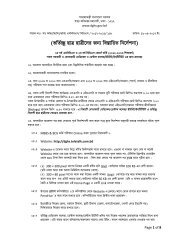Health Bulletin 2009
Health Bulletin 2009
Health Bulletin 2009
You also want an ePaper? Increase the reach of your titles
YUMPU automatically turns print PDFs into web optimized ePapers that Google loves.
Control of communicable diseases<br />
The prevention and control of communicable diseases represent a significant challenge to those<br />
providing health-care services in Bangladesh. Sound knowledge on the disease epidemiology is<br />
a must for the health service providers in various levels.<br />
The Bangladesh population is namely affected by diarrheal diseases, cholera, hepatitis A & E,<br />
Malaria, Mycobacterial Disease like Tuberculosis and Leprosy, Dengue, Japanese encephalitis,<br />
Nipah virus infection, etc.<br />
Crowding, poor access to safe water, inadequate hygiene and toilet facilities, and unsafe food<br />
preparation and handling practices are associated with transmission. Cholera is endemic<br />
Bangladesh, between 800 and 1000 cases are usually being recorded daily at the hospital of<br />
the ICCDR, B in Dhaka. Hepatitis A and E levels are usually high in the country.<br />
Malaria risk exists throughout the year in Bangladesh. Thirteen out of 64 administrative districts<br />
are high malaria endemic areas. 98% of all malaria cases reported are from these districts,<br />
which are mainly located in the border areas of India and Myanmar.<br />
Tuberculosis still remains as a major public health problem, which ranks Bangladesh fifth<br />
among the high-TB burden countries in the world. The present revised National Tuberculosis<br />
Programme (NTP) was launched and field implementation of DOTS (Directly Observed<br />
Treatment short course) was started in 1993.<br />
Leishmaniasis or Kala Azar is endemic in Bangladesh and has an incidence of 175 per 100,000<br />
per annum. It is caused by a protozoa which is transmitted from the bite of infected sandfly and<br />
may present in cutaneous or visceral forms (particularly common in Bangladesh).<br />
Filariasis is a mosquito borne parasitic disease causillili<br />
urogenital organs, breast, etc. with long arm disability. In Bangladesh, it is endemic in 23<br />
districts, mostly the bordering ones. About 20 million people are already infected, most of whom<br />
are incapacitated.<br />
Leprosy has been a major health problem in Bangladesh for a long time. Bangladesh was<br />
considered a high endemic country and was listed among ten countries with high case load<br />
(1992). Leprosy situation has changed globally after 1981 when the Multi Drugs Treatment<br />
(MDT) were introduced.<br />
Hepatitis A virus infection is common in Bangladesh with a prevalence of about 2% to 7%.<br />
Prevalence of hepatitis C virus infection is less than 1%. Sporadic outbreak is often seen<br />
caused by hepatitis E virus infection; but presence of hepatitis D infection is not exactly known.<br />
Polio free status prevailed from 2001 until now (June <strong>2009</strong>) except a small window period in<br />
2006 when 18 cases of child polio were seen in boarder areas of Bangladesh. it is assumed that<br />
these cases were imported from India.<br />
23


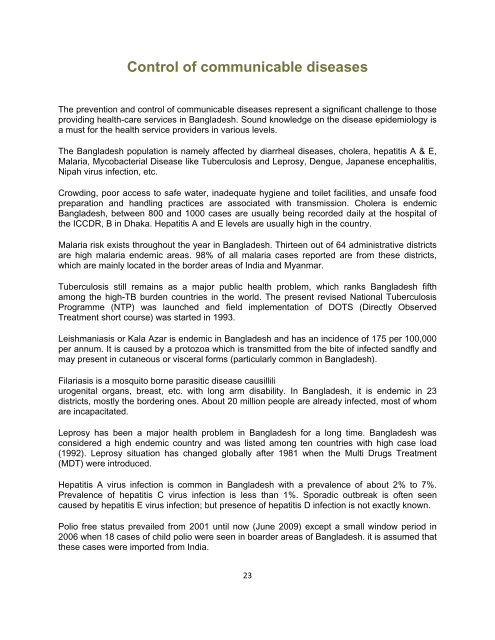
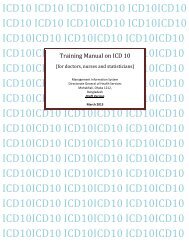




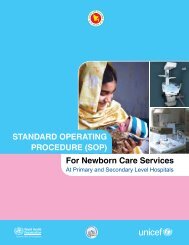
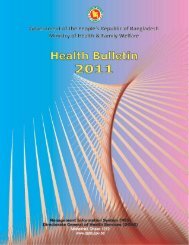
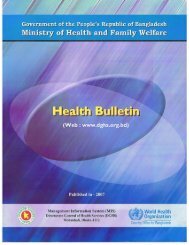
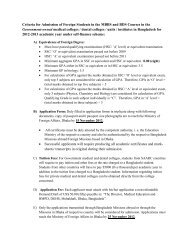
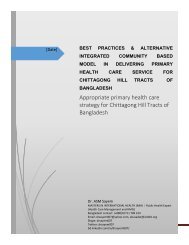
![Bangladesh Demographic and Health Survey 2007 [FR207]](https://img.yumpu.com/38440445/1/190x257/bangladesh-demographic-and-health-survey-2007-fr207.jpg?quality=85)
